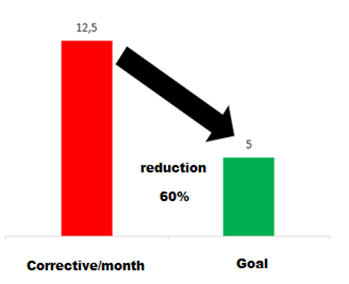Implementation of autonomous maintenance to pneumatic tools in an assembly line
DOI:
https://doi.org/10.33131/24222208.365Keywords:
Autonomous Maintenance, Focused Improvement, Pneumatic networks, Total Production Maintenance.Abstract
The automotive sector's assembly and manufacturing companies have pneumatic network systems composed of piping systems, hoses, and pneumatic impact and impulse tools used for product adjustment and assembly processes. Most of these companies do not include this equipment within their preventive maintenance plans because it is not considered a fundamental part of the production process. For this reason, corrective maintenance of the equipment mentioned above only is applied when an unforeseen stop happens. When a failure occurs, production is stopped in an unscheduled manner, causing high repair costs and loss of production time and quality of the assembled product. There are also high energy consumption costs due to air leakage in the pneumatic network, which also affects the delivery compliance of the finished product. This paper presents a methodological proposal for implementing a focused improvement project for the pneumatic tools of assembling lines based on autonomous maintenance, one of the pillars of Total Production Maintenance. Line operators are solely responsible for equipment inspection to anticipate potential failures and thus make scheduled stops for equipment intervention, improving the quality of the finished product and avoiding accidents or losses due to breakdowns. The proposed solution manages to increase the pneumatic line's availability from 88% to 98%.
Downloads
References
E. A. Duque Grisales, J. Molina Flórez, and N. Ossa Núñez, “Operación del sistema de autocontrol y gestión del riesgo de lavado de activos y financiación del terrorismo en empresas del sector comercial,” Revista CINTEX, vol. 23, no. 1, pp. 32–42, Oct. 2018, doi: https://doi.org/10.33131/24222208.306.
D. A. Bonilla-Vargas and E. A. Duque Grisales, “Estudio sobre opciones de financiación para las pequeñas y medianas empresas de la ciudad de Medellín,” Rev. Cintex, vol. 25, no. 1, pp. 54–67, Dec. 2020, doi: 10.33131/24222208.359.
D. Carnerud, C. Jaca, and I. Bäckström, “Kaizen and continuous improvement – trends and patterns over 30 years,” TQM, vol. 30, no. 4, pp. 371–390, Jul. 2018, doi: 10.1108/TQM-03-2018-0037.
V. Janjić, M. Todorović, and D. Jovanović, “Key Success Factors and Benefits of Kaizen Implementation,” Engineering Management Journal, vol. 32, no. 2, pp. 98–106, Apr. 2020, doi: 10.1080/10429247.2019.1664274.
T. K. Agustiady and E. A. Cudney, “Total productive maintenance,” Total Quality Management & Business Excellence, pp. 1–8, Feb. 2018, doi: 10.1080/14783363.2018.1438843.
J. L. García Alcaraz, “Factores relacionados con el éxito del mantenimiento productivo total,” Revista Facultad de Ingeniería Universidad de Antioquia, no. 60, pp. 129–140, Sep. 2011.
A. Valles-Chavez and J. Sanchez, “Definition of the Guide for Implementation Lean,” in Six Sigma Projects and Personal Experiences, A. Coskun, Ed. InTech, 2011. doi: 10.5772/16570.
L. Vargas Monroy, “Implementación Del Pilar ‘Mantenimiento Autónomo’ En El Centro De Proceso Vibrado De La Empresa Finart S.A.S,” Tesis Ingenieria, Universidad Distrital Francisco José De Caldas, BOGOTA D.C., 2016. [Online]. Available: https://repository.udistrital.edu.co/bitstream/handle/11349/3162/VargasMonroyLisseth%20Camila2016.pdf?sequence=3
J. D. Vahos, A. A. Pino, and J. J. Castro Maldonado, “Desarrollo de una herramienta de software para la gestión del mantenimiento de infraestructura en el SENA regional Antioquia,” Rev. Cintex, vol. 24, no. 1, pp. 13–19, Dec. 2019, doi: 10.33131/24222208.331.
M. I. Ardila Marín, W. Orozco Murillo, J. Galeano Echeverri, and A. M. Medina Escobar, “Desarrollo de software para la gestión del mantenimiento en los laboratorios de la I.U. Pascual Bravo,” Revista CINTEX, vol. 23, no. 1, pp. 43–50, Oct. 2018.
C. Hernandez, D. Velez, and J. A. Isaza, “Diseño de una plataforma de prueba de sensores virtuales para el sistema glucosa-insulina de pacientes UCI usando la técnica HIL,” Revista CINTEX, vol. 23, no. 2, pp. 61–75, Dec. 2018, doi: 10.33131/24222208.318.
M. Jiménez, L. Romero, M. Domínguez, and M. del M. Espinosa, “5S methodology implementation in the laboratories of an industrial engineering university school,” Safety Science, vol. 78, pp. 163–172, Oct. 2015, doi: 10.1016/j.ssci.2015.04.022.
P. Guariente, I. Antoniolli, L. P. Ferreira, T. Pereira, and F. J. G. Silva, “Implementing autonomous maintenance in an automotive components manufacturer,” Procedia Manufacturing, vol. 13, pp. 1128–1134, 2017, doi: 10.1016/j.promfg.2017.09.174.
O. Tinoco Gómez, F. Tinoco Ángeles, and E. Moscoso Huaira, “Aplicación de las 5S para mejorar la percepción de cultura de calidad en microempresas de confecciones textiles en el Cono Norte de Lima,” idata, vol. 19, no. 1, p. 33, Oct. 2016, doi: 10.15381/idata.v19i1.12535.
G. Pinto, F. J. G. Silva, A. Baptista, N. O. Fernandes, R. Casais, and C. Carvalho, “TPM implementation and maintenance strategic plan – a case study,” Procedia Manufacturing, vol. 51, pp. 1423–1430, 2020, doi: 10.1016/j.promfg.2020.10.198.
J. E. Valdez García, “Implementación Del Mantenimiento Autónomo Para Aumentar La Disponibilidad De Equipos Trackless En Uchucchacua,” Master, Universidad Nacional Del Centro Del Perú, Huancayo – Perú, 2017. [Online]. Available: https://repositorio.uncp.edu.pe/handle/20.500.12894/3937
A. Azizi, “Evaluation Improvement of Production Productivity Performance using Statistical Process Control, Overall Equipment Efficiency, and Autonomous Maintenance,” Procedia Manufacturing, vol. 2, pp. 186–190, 2015, doi: 10.1016/j.promfg.2015.07.032.
R. Singh, A. M. Gohil, D. B. Shah, and S. Desai, “Total Productive Maintenance (TPM) Implementation in a Machine Shop: A Case Study,” Procedia Engineering, vol. 51, pp. 592–599, 2013, doi: 10.1016/j.proeng.2013.01.084.
J. D. Morales Méndez and R. S. Rodriguez, “Total productive maintenance (TPM) as a tool for improving productivity: a case study of application in the bottleneck of an auto-parts machining line,” Int J Adv Manuf Technol, vol. 92, no. 1–4, pp. 1013–1026, Sep. 2017, doi: 10.1007/s00170-017-0052-4.
P. N. Muchiri, L. Pintelon, H. Martin, and P. Chemweno, “Modelling maintenance effects on manufacturing equipment performance: results from simulation analysis,” International Journal of Production Research, vol. 52, no. 11, pp. 3287–3302, Jun. 2014, doi: 10.1080/00207543.2013.870673.

Downloads
Published
How to Cite
Issue
Section











